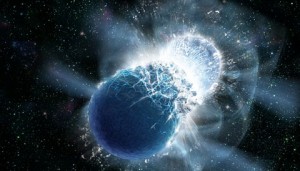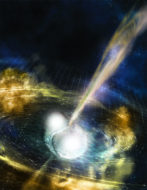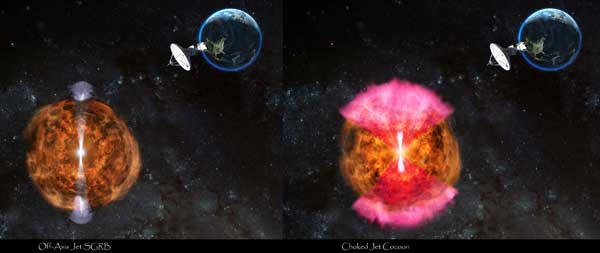LIGO’s neutron-star smashup might not have been a typical short gamma-ray burst. If true, the detection points toward a new class of gamma-ray bursts — but the jury is still out.

Dana Berry / SkyWorks Digital, Inc.
It was astrophysicists’ dream-come-true: In October scientists announced the first direct sighting of a smashup of two neutron stars, the compressed cores of massive dead stars. The event produced both gravitational waves, a shimmying of space-time itself, and electromagnetic radiation. Indeed, by the time the first papers were released, astronomers had gathered data at roughly 70 different observatories. Some had even imaged a short gamma-ray burst, an explosion so powerful that it’s one of the brightest in the universe.
As such, the event was the first definitive proof that short gamma-ray bursts are caused by these neutron-star collisions — a finding that Brian Metzger (Columbia University) calls a Holy Grail within the field.
But a new study published December 20 in <i>Nature</i> shows that astronomers might have been too fast to jump to such conclusions. Kunal Mooley (University of Oxford) and his colleagues found that the radio waves that they observed for more than 100 days after the merger didn’t behave as expected, but instead suggest that the short gamma-ray burst is anything but typical.
As such, Mooley and his colleagues argue that the event marks the first detection of a new class of short gamma-ray bursts. But not all astronomers are so quick to agree
Short Gamma-ray Burst Fireworks
A mere 1.7 seconds after gravitational waves passed through both LIGO in the United States and Virgo in Italy, NASA’s Fermi telescope spotted a burst of gamma rays in the same neighborhood of the sky. Other telescopes swung into action and within 12 hours, a glow of visible and infrared light was spotted. More than a week later, as those wavelengths faded away, X-rays became visible, followed by radio waves. The smashup had sparked fireworks.

NSF / LIGO / Sonoma State University / A. Simonnet
Astronomers recognized those fireworks as the telltale signature of a short gamma-ray burst. Though these astrophysical oddities pop up in the sky every few weeks, astronomers still don’t have definitive proof of their origins. They think they arise when a pair of neutron stars collide and blast a fast-moving and beam-like jet toward the Earth. Viewed face-on, they are extremely bright. But the gamma-ray signals produced in this event were 10,000 times dimmer than those seen in other short gamma-ray bursts.
To explain the conundrum, many astronomers thought the jet was simply facing slightly away from the Earth. Because they weren’t viewing it face-on — down the barrel of the gamma-ray-burst gun — it would have appeared dimmer than expected. Somewhere else, an alien observer with a luckier line of sight would have detected a typical short gamma-ray burst.
The explanation made sense. “We would have had to be extraordinarily lucky to see the event directly head on,” says Metzger. “It’s just very improbable.”
But not all scientists were content with that answer. Mooley and his colleagues continued tracking the glow with three radio telescope arrays — the Karl G. Jansky Very Large Array in New Mexico, the Australia Telescope Compact Array, and the Giant Metrewave Radio Telescope in India — for more than 100 days after the collision.
Had the explosion been a typical short gamma-ray burst but with an off-axis jet, Mooley’s team would have been able to detect its signature. “If you accelerate a lightbulb close to the speed of light, Einstein’s special theory of relativity tells you that the bulb will emit light only in the direction that it is moving,” Mooley says. “Whereas if you slow it down, then it will start emitting light in all different directions.” As such, Mooley and his colleagues expected to see a sudden increase in radio waves as the jet slowed down and the light expanded in our direction.
The problem is, they didn’t.
All Neutron-star Smashups Aren’t Equal
Instead, what Mooley’s team saw was a steady brightening — the signature of a glowing cocoon surrounding the smashup. To explain the cocoon, the team thinks that a jet failed to punch through the shell of material kicked out in the neutron-star crash, instead transferring most of its energy to the debris and pushing it outward to form a bubble-like structure. That means that observers cannot see the failed jet, if it still exists, only the billowing cocoon of neutron-rich material.

NRAO / AUI / NSF / D. Berry
Mooley and his colleagues interpret this scenario as an entirely new class of gamma-ray bursts: the jet, if there is one at all, isn’t responsible for the emissions they see. Nor is there an alien observer anywhere that would have seen a run-of-the-mill short gamma-ray burst. “It’s not a typical kind of event that has been seen in the past — in fact, it's something completely different,” Mooley says.
Mitchell Begelman (University of Colorado), who was not involved in the study, compares the two classes to a jet of water at the bottom of a swimming pool. If the jet is really powerful, he explains, it will punch straight through the water and you’ll see a waterspout above the pool’s surface. This is a typical short gamma-ray burst. But if it’s a little less powerful, it will fizzle out inside the pool, creating a slight movement on the surface of the water. This is the new class of gamma-ray bursts that Mooley and his colleagues have observed.
Video credit: Ehud Nakar (Tel Aviv), Ore Gottlieb (Tel Aviv), Leo Singer (NASA), Mansi Kasliwal (Caltech), and the GROWTH collaboration
A Cosmic Debate
Begelman finds the evidence moderately convincing, as astronomers would have had to resort to some “pretty tricky arguments” to make the off-axis jet scenario work.
But other astronomers are preparing to do just that. Metzger, for example, points toward several papers currently in the pipeline that will soon argue that a successful, off-axis jet can still explain the latest data and that this event is a typical short gamma-ray burst. “There’s definitely going to be some challenge to the [study],” he says. For his part, he agrees that astronomers don’t have definitive proof of an off-axis short gamma-ray burst in this event, but he doesn’t think the data rules out that interpretation entirely.
Andrew MacFadyen (New York University), who was also not involved in the study agrees that neither scenario can be ruled out. “It's not a slam dunk,” he says of the study.
To some extent, the debate isn’t terribly surprising. To begin, we still don’t have an agreed-upon model that explains how gamma-ray bursts work. And it doesn’t help that the gamma-ray bursts we’ve seen to date have been the brightest variety, where we’re looking straight down the barrel — we’ve never seen such an explosion off-axis before, Metzger says.
Either way, the results show that there is not yet a definitive link between neutron star mergers and short gamma-ray bursts. Metzger’s Holy Grail has yet to be found.
Reference:
K. P. Mooley et al. “A mildly relativistic wide-angle outflow in the neutron-star merger event GW170817.” Nature.
 2
2









Comments
Edward Schaefer
December 26, 2017 at 12:51 pm
It may also be possible that the lack of a jet is a regular occurrence in short GRBs. See https://arxiv.org/abs/astro-ph/0603773 .
You must be logged in to post a comment.
xinhangshen
January 4, 2018 at 10:22 am
Please don't use the term "spacetime" because there is nothing called "spacetime" in nature as Einstein's relativity has already been disproved and time is absolute and independent of space! The most obvious evidence for the absolute time is that the universal synchronization of all the atomic clocks on the GPS satellites which show the same absolute time.
You must be logged in to post a comment.
You must be logged in to post a comment.